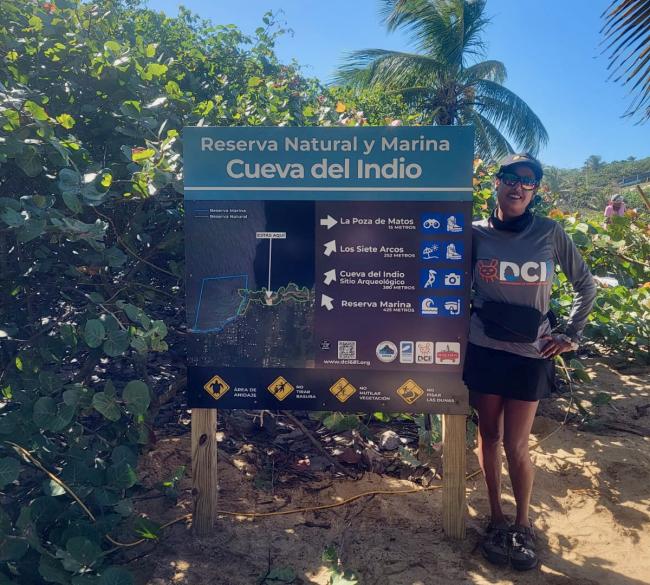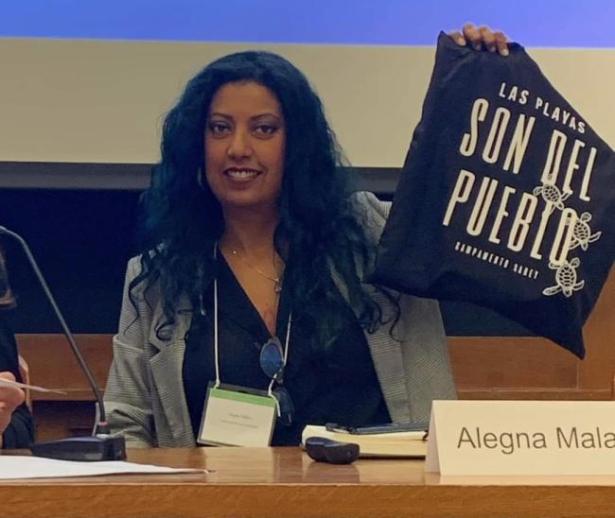Last April, Alegna Malavé Marrero joined fellow community activists in removing the fencing and vegetative debris that block public access to the Cueva del Indio Nature and Marine Reserve in the northern town of Arecibo in Puerto Rico. A veteran of environmental protest, she came prepared with Puerto Rico’s Council for Protection of Archaeological Lands regulatory policy Laws 111 and 112, which dictate the protection and preservation of terrestrial archaeological sites, including caves and caverns intrinsic to the conservation of Puerto Rico’s natural and cultural heritage.
For the past seven years, both entrances to the reserve have remained illegally obstructed by business magnate José González Freyre, owner of Pan American Grain. González Freyre, who purchased land adjacent to the Nature Reserve, placed fencing and debris around the caves, effectively closing off access to the site. Home to a delicate ecosystem of flora, fauna, rock formations and marine species, like hermit crabs and the endangered green sea turtle, the reserve is also an archaeological site featuring hundreds of ancient rock art carvings from Puerto Rico's first inhabitants. Choosing April 9 for their manifestation was no coincidence; it marked the 31st anniversary of the site’s designation as a Natural Reserve by Puerto Rico’s Department of Natural & Environmental Resources (DRNA). In 2015, the area was also named a Marine Reserve by the Puerto Rico Legislature.
According to these laws, it is a felony to appropriate, mutilate, or loot a registered archaeological site. Further, by charging visitors for parking, González Freyre is exploiting the site for personal profit.
Involved in organizing since 2005, Malavé Marrero has long advocated for protecting and preserving her country’s natural resources, delicate ecosystems, and Indigenous heritage. From organizing grassroots efforts demanding the demolition of an illegal construction in Puerto Rico’s northwestern coastal town of Aguadilla, to testifying at legislative hearings, to camping out for a week to protest private construction on public land, her mission is clear: to stop rampant development that is destroying Puerto Rico’s marine and nature reserves.
As spokesperson for Defending la Cueva del Indio (DCI-681), an educational, community-based organization promoting the preservation of the Indigenous cave located along the region’s coastal route PR-681, Malavé Marrero is determined to safeguard its cultural significance. On April 9 activists managed to remove part of the fencing, but community access to the caves remains closed.
Formally trained as a socio-spatial planner—focusing on land use based on ample citizen participation and sociological knowledge applied within an urban context—Malavé Marrero uses her knowledge of Puerto Rican regulatory policy to educate communities about illegal land use and the threats posed to agricultural and natural resources. She does so against the backdrop of current Governor Pedro Pierluisi’s pro-statehood administration — one that prioritizes the interests of private investors. In this interview, Malavé Marrero shares insights on the current political climate she describes as “a threat not only to those of us living in Borikén [Puerto Rico’s Indigenous name] but also to all of the natural species of marine life that call this their home.”
This interview has been edited for length and clarity.
Lola Rosario: When many hear the word “coastline” they think of beaches, but in Puerto Rico it’s more than that. Share with us what other coastal areas are being negatively impacted.
Alegna Malavé Marrero: In the town of Salinas, in southern Puerto Rico, the National Estuarine Research Reserve Bahía de Jobos is among 30 reserves managed by the National Oceanic and Atmospheric Administration . It is an area made up of mangroves and beaches. Despite the on-site presence of guards from the DRNA, there have been documented witnessings of mangrove burnings and illegal construction of docks. Community members have been organizing since the 1980s, trying to protect the area known as Paso del Indio y Cueva León due to its ancestral significance. A place inhabited since the times of our Indigenous Taíno forebears, residents there are resisting displacement and fighting to protect their natural area.
It’s important to understand the mangroves’ critical role in forming the Estuarine Reserve’s barrier between the open sea and dry land, especially during times of flooding. Deforestation and burning of mangroves are also destroying bird nests and marine life. All of this is happening in the federal government’s presence . It must not go unnoticed; there have to be consequences.

Alegna Malavé Marrero poses next to the entrance to the Cueva del Indio Nature and Marine Reserve, which has been inaccesible to the public since 2016. (Photo courtesy of (Alegna Malavé Marrero)
LR: How does the government’s pro-privatization stance factor into the equation of further endangering marine life and the archipelago’s Indigenous heritage?
AMM: Pedro Pierluisi's administration insists on using Joint Regulation (JR) 2020, legislation pertaining to the Evaluation and Issuance of Permits Related to Development, Land Use, and Business Operations [this legislation was nullified by Puerto Rico Supreme Court in March 2023]. JR 2020 would reconfigure land use, but by renaming it an “Emergency Joint Regulation” Pierluisi’s government is ignoring the court ruling and instead using it as a tool to facilitate the deregulation of territorial plans, allowing illegal constructions in natural, agricultural, and historical reserves. As a community organizer for the Asamblea de Pueblo (People's Assembly), I was tasked with educating communities about the dangers of JR 2020 and the importance of active citizen participation in public hearings and submitting comments to protect livability in the communities from commercial encroachment and displacement.
When we see what’s happening in the neighborhood of Islote in the northern coastal town of Arecibo with the Cueva del Indio Nature and Marine Reserve, this administration’s position is clear — privatization and dollar signs trump any environmental concerns. In 2016, José González Freyre closed off access to the archaeological site. When activists attempt to access the area, Carlos Mena, administrator of González Freyre’s property, rebukes them by brandishing a firearm and charging between $10 and $35 for vehicle parking. Their privatization of the area was nothing more than usurpation and exploitation.
In July 2022, Islote community leader Lauce Colón Pérez reported the land appropriation, citing the DRNA's 1974 demarcation limits relevant to Puerto Rico's maritime terrestrial zone. According to the demarcation, the direct access route to Cueva del Indio that was established is currently being privatized by González Freyre. As for my organization, at DCI-681 our mission is to preserve the cultural significance of the Cueva del Indio with the goal of developing a sustainable management plan that conforms to the highest environmental and social standards. By forming alliances with community organizations, the municipality of Arecibo, the DRNA, and the Institute of Puerto Rican Culture, we would formulate a cohesive program — one that centers education on environmental and cultural protection.
LR: Thinking about land use and development, the slogan “The Beaches are Public Domain” comes to mind. Can you take us behind the scenes for a closer perspective on its meaning?
AMM: Our work is about much more than chants and rallying cries. “Las Playas Son del Pueblo” carries with it a reminder to the government and private interests that our beaches and natural resources are not for sale. Consider the situation in Cueva Las Golondrinas, a marine cave located in the northwestern coastal town of Aguadilla. Between 2019 and 2020, businessman Carlos Román González illegally obtained permits through his construction company, Aguadilla Pier Corp (APC), to begin building permanent structures on top of the cave. Over the past few years, there have been countless protests demanding that the DRNA order the demolition of the property (which includes a gazebo and an equestrian facility).
During a manifestation this past January, things got very intense. As unarmed activists approached the heavily guarded complex, taking videos and shouting, César Toledo Montilla, a member of Román González’s private security detail, fired at the crowd of protestors. One of his bullets landed embedded in the lower leg of environmental advocate Ángel Luis Torres Rosado, who was subsequently rushed to a nearby hospital. Torres Rosado eventually healed from his physical injury; however, everyone understands the severity of what happened. That bullet could have easily ended someone’s life. In this environmental struggle, the stakes are high. We’re up against corruption and folks with deep pockets — it has been reported that Román González has made hefty monetary contributions to both of Puerto Rico’s main political parties, the PNP [New Progressive Party] and the PPD [Popular Democratic Party]. Our commitment to the statement “the beaches are public domain” is non-negotiable.
LR: As a sociologist, what role does your academic background play in advocating for the coastlines vis-à-vis your interaction with police and local authorities?
AMM: I, and others, are in this struggle because we are fighting for this country we love so much. Being passionate about our heritage, natural resources, and the environment moves us to do what we do. Trained as a sociologist, I’m well attuned to the dynamics of protest. As activists/cultural advocates, our emotions are inextricably tied to this work — as I discussed earlier, potential dangers exist. That’s why when I’m present at these manifestations, I watch over the physical and emotional safety of those in my group. Further, as the daughter of a nurse, our collective well-being is one of my priorities.
When it comes to local authorities, it’s crucial to be mindful of their role. The police represent an inherent capacity of elected officials/government to control its citizens. What I denounce is the illegal use of force in their authoritative power against activists — it’s visible in how the police are equipped with protective shields, helmets, batons, teargas, handcuffs, and sometimes even with guns. Clearly, they are present to maintain order. This being the case, I’m certainly not going to start arguing with them about Joint Regulation 2020 or other local ordinances. They’ll say (as a few have said to me in the past), “I don’t know about those laws, I’m just here following orders.” So, I avoid debating legalese with them; I save that for when I’m in court testifying against illegal construction. Then, after presenting evidence in the form of video, photographic images, and missing permits, we wait for a judge to order the demolition of said construction. It is this document I show to the senior police officer in charge of the squadron at a given protest. By giving them the facts, I’m reminding them it’s their job to ensure the law is upheld.
LR: And, are you seeing changes in those instances? Is the rule of law being followed?
AMM: In Puerto Rico, the government continues to allow illegal constructions in protected nature reserve areas. Where I am seeing change is in greater awareness of public domain land use and the legalities thereto. As environmental justice seekers, we need to utilize effective strategies in our fight. We do so through the use of knowledge of policy and education.
One instance that stands out recently relates to a wall [we painted on] at the beach in Sol y Playa on the west coast of Rincón, in protest of the illegal construction of a condominium pool directly adjacent to the shoreline. I heard a police officer referencing environmental law, which makes me very optimistic. This is a step in the right direction because now we have law enforcement officials becoming engaged and informed of the laws that are being broken.
Lola Rosario is a New York City-raised Afro Boricua cultural storyteller and spoken word poet. Her work focuses on feminism, cultural identity, and social justice issues impacting her ancestral homeland of Borikén.
The North American Congress on Latin America (NACLA) is an independent, nonprofit organization founded in 1966 to examine and critique U.S. imperialism and political, economic, and military intervention in the Western hemisphere. In an evolving political and media landscape, we continue to work toward a world in which the nations and peoples of Latin America and the Caribbean are free from oppression, injustice, and economic and political subordination. For more about NACLA and our work, read our history.


Spread the word